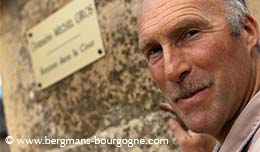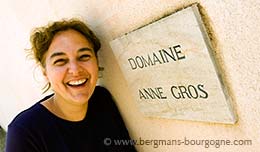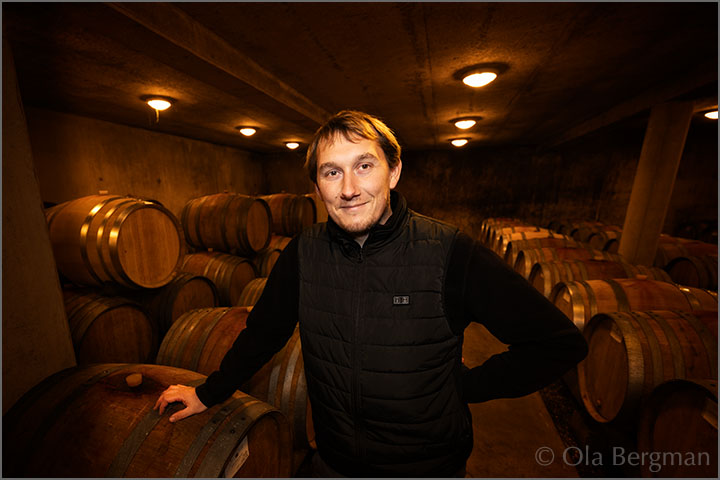
oth the domaine and the village have moved from red towards white. During the last generation Domaine Jean-Pierre Maldant in Ladoix-Serrigny has increased the white wine portion considerably. It is now 30 per cent of the annual output.
– Ladoix has been known as a red village, but now much is planted with chardonnay. The white sells well, but the red even better. I produce 10 000-12 000 bottles of red Ladoix. And I never have enough to sell. Because it’s a good price/quality ratio. Fifteen years ago it was much more difficult. The Aloxe-Corton wine were not particularly expensive back then, but when the prices began to go up the Ladoix wines gained in popularity.
Pierre-François Maldant is in the cellars of his domaine in the middle of Ladoix-Serrigny, right next to the Beaune-Dijon road, which cuts through the village. He is the fifth generation at the domaine.
 – My father made almost no white wine, he continues. There was the Corton-Charlemagne and a bit of Bourgogne blanc. Towards the end of his career he stared to replant some of our Ladoix vineyards with chardonnay. Since then I have planted more white – Bourgogne, Ladoix and Bourgogne Hautes-Côtes de Beaune in Pernand-Vergelesses. I have also taken on the Chorey-lès-Beaune, Les Beaumonts, vineyards, which is part red and part white. I also run a small négociant business with my sister Emilie.
– My father made almost no white wine, he continues. There was the Corton-Charlemagne and a bit of Bourgogne blanc. Towards the end of his career he stared to replant some of our Ladoix vineyards with chardonnay. Since then I have planted more white – Bourgogne, Ladoix and Bourgogne Hautes-Côtes de Beaune in Pernand-Vergelesses. I have also taken on the Chorey-lès-Beaune, Les Beaumonts, vineyards, which is part red and part white. I also run a small négociant business with my sister Emilie.
The Maldant family is originally from Pommard. They later moved to Ladoix-Serrigny. They owned vineyards, but were also responsible for the vineyards at the Hospice de Beaune.
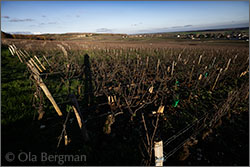 – My father stopped taking care of the Hospice de Beaune vineyards in 1998, in order to be able to focus fully on the domaine. It was just five-six hectares at the time. Today we have ten hectares. I don’t want much more than that. It is a size which allows you to oversee everything. You can make a living out of it, you can invest and you don’t have the stress that comes with running a 25 hectare domaine.
– My father stopped taking care of the Hospice de Beaune vineyards in 1998, in order to be able to focus fully on the domaine. It was just five-six hectares at the time. Today we have ten hectares. I don’t want much more than that. It is a size which allows you to oversee everything. You can make a living out of it, you can invest and you don’t have the stress that comes with running a 25 hectare domaine.
– I started vinfying in 2010. I was employed by the domaine. Then in 2014 I bought the company. And then in 2020 my mother, who had been a partner, retired.
There is another winemaking branch of the family. Domaine Maldant-Pauvelot in Chorey-lès-Beaune are cousins. For instance, both domaines have Aloxe-Corton premier cru, Les Valozières – the original parcel split in two.
– Originally there were three brothers and sisters, says Pierre-François Maldant. Hubert, my grandfather Pierre-François and Marie-Louise, who owned this house. She had no children, so she left the house to my father. His brother Hubert set up his thing in Chorey-lès-Beaune. My grandfather lived in the house next door here.
 Ladoix-Serrigny is the northern end of the Côte de Beaune. Immediately to the north is where the Côte de Nuits vineyards begin. The vineyards of Domaine Jean-Pierre Maldant are centered around the Corton hill. The majority of the vineyards are only one kilometre from the domaine. The furthest south are the Savigny-lès-Beaune vineyards.
Ladoix-Serrigny is the northern end of the Côte de Beaune. Immediately to the north is where the Côte de Nuits vineyards begin. The vineyards of Domaine Jean-Pierre Maldant are centered around the Corton hill. The majority of the vineyards are only one kilometre from the domaine. The furthest south are the Savigny-lès-Beaune vineyards.
The average size of a domaine in Burgundy is eight hectares. With its ten hectares Domaine Jean-Pierre Maldant is slightly larger. And in true Burgundian manner there is a large number of appellations. 22 in total.
– We have always separated the red village appellation Ladoix into three cuvées in order to keep the terroirs apart, Pierre-François Maldant. From a commercial point of view it would have been easier to make one single cuvée instead. But that would be a pity, because the terroirs are really different.
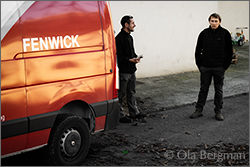 In addition to three red Ladoix cuvées – Ladoix Vieilles Vignes, Ladoix Les Chaillots and Ladoix Les Buis – there are two white – Ladoix and Ladoix Les Buis.
In addition to three red Ladoix cuvées – Ladoix Vieilles Vignes, Ladoix Les Chaillots and Ladoix Les Buis – there are two white – Ladoix and Ladoix Les Buis.
– The Ladoix blanc is a cuvée with notes of exotic fruits, easy to drink young, explains Pierre-François Maldant. Les Buis has more complexity.
– For the Ladoix blanc the grapes come from two different plots. Les Ranches, which is on the Côte de Nuits side, and Les Chaillots, which is at the bottom of the Corton hill. The blend is roughly fifty-fifty. Both are young vines. The oldest is about 25 years. The other 15. Les Ranches is a limestone slope. Not very deep soil. Lots of têtes des moutons, large round stones. Les Chaillots is clay. Deep soil. Les Chaillots produce a rich wine, whereas Les Ranches is more about minerality and elegance.
 – Les Buis is a completely different thing. It’s on the slope. Les Buis is much richer as a wine. It’s a slope which faces straight south. It’s in the middle of the premier crus. This part of Les Buis is not yet classified as premier cru, but I’m sure it will be. It was part of the wood above and then cleared and planted, but it was not granted premier cru status. Les Buis is rich and opulent. But in dry years, like 2022, Les Buis is very difficult, because the vines suffer from drought. In a good year I produce four barrels.
– Les Buis is a completely different thing. It’s on the slope. Les Buis is much richer as a wine. It’s a slope which faces straight south. It’s in the middle of the premier crus. This part of Les Buis is not yet classified as premier cru, but I’m sure it will be. It was part of the wood above and then cleared and planted, but it was not granted premier cru status. Les Buis is rich and opulent. But in dry years, like 2022, Les Buis is very difficult, because the vines suffer from drought. In a good year I produce four barrels.
As with Ladoix, Les Buis, the Chorey-lès-Beaune, Les Beaumonts, of Domaine Jean-Pierre Maldant comes in both colours.
– What makes my white Chorey-lès-Beaune special is that it is 100 per cent pinot blanc. The vines are more than 80 years old. But quantities are very low. You are allowed to make a 100 per cent pinot blanc in Chorey-lès-Beaune and Savigny-lès-Beaune, but not in Ladoix.
 Another rarity of the domaine is the Bourgogne La Chapelle Notre-Dame, one of the few regional appellation wines where the addition of the climat on the label is allowed. It is a four and half hectare vineyard on the ”wrong” side of the Beaune-Dijon road in Ladoix-Serringny. It is right next to the 11th century chapel Notre Dame du Chemin. Apart from Domaine Jean-Pierre Maldant only four other domaines produce the appellation – Domaine Cachat-Ocquidant, Domaine Nudant, Domaine Dubreuil-Fontaine and Domaine Maratray-Dubreuil (who does not mention it on the label).
Another rarity of the domaine is the Bourgogne La Chapelle Notre-Dame, one of the few regional appellation wines where the addition of the climat on the label is allowed. It is a four and half hectare vineyard on the ”wrong” side of the Beaune-Dijon road in Ladoix-Serringny. It is right next to the 11th century chapel Notre Dame du Chemin. Apart from Domaine Jean-Pierre Maldant only four other domaines produce the appellation – Domaine Cachat-Ocquidant, Domaine Nudant, Domaine Dubreuil-Fontaine and Domaine Maratray-Dubreuil (who does not mention it on the label).
– We have always made Chapelle, says Pierre-François Maldant. The vines are very old. One could say that in terms of quality it is halfway between a regional appellation and a village appellation. We have another Bourgogne rouge cuvée. It is also in Ladoix, but closer to Chorey-lès-Beaune. There is no comparison. The soil is exactly the same as the lower part of Les Valozières in Aloxe-Corton across the road. Much clay, with chailles, small brown stones. Deep soil. This part never suffers from drought, but it can be tough in wet years when it’s difficult to drive the tractor there.
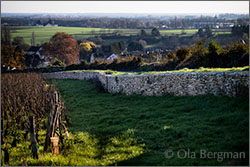 Since his arrival at the domaine Pierre-François Maldant has made changes. He is still in conventional farming, but he is moving towards organic farming in the medium term. Conventional farming has no future, he points out. Insecticides haven’t been used for many years. The number of treatments in the vineyards has gone down, with half of them being organic today..
Since his arrival at the domaine Pierre-François Maldant has made changes. He is still in conventional farming, but he is moving towards organic farming in the medium term. Conventional farming has no future, he points out. Insecticides haven’t been used for many years. The number of treatments in the vineyards has gone down, with half of them being organic today..
– The cuvaisons are generally short here. There is no pigéage. Never. I stopped that in 2018. Aloxe-Corton has always produced rustic tannins. In 2017 we experimented with village appellation Aloxe-Corton and the premier cru Les Valozières. We did no pigéage and lots of remontage instead. The cuvasions were shortened to ten-eleven days in order to avoid extracting bad tannins. It worked out very well and we have continued. What I’m looking for is elegant wines with fruit.
– All reds are now made in the same way. I’m just adapting to appellation and vintage. When the vintage allows we include 20-30 per cent whole bunches. We use very little new oak. Élevage is 100 per cent in barrel, but we keep our barrels for quite long, up to 10-12 years. 15-20 per cent new oak is a maximum. Maybe 30-35 per cent or the grand crus.
 There are two village appellation Aloxe-Cortons and two premier crus at Domaine Jean-Pierre Maldant. The main village appellation Aloxe-Corton is 95 per cent Bas des Valozieres. The rest is Les Morais, a lieu-dit which touches Les Valozières.
There are two village appellation Aloxe-Cortons and two premier crus at Domaine Jean-Pierre Maldant. The main village appellation Aloxe-Corton is 95 per cent Bas des Valozieres. The rest is Les Morais, a lieu-dit which touches Les Valozières.
– The other cuvée is Les Crapousuets. It is south of Aloxe-Corton. It is more elegant. It’s small cuvée. In a very good year I make six barrels. It’s a nice terroir. It’s close to Chorey-lès-Beaune and at times it resembles Les Beaumonts. The vines are old, about 80 years.
The two Aloxe-Corton premier crus – Les Valizières and Les Maréchaudes – are not far from each other, but they are distinctly different in style.
– In Les Maréchaudes the soil is not as deep. It is very similar to the lower part of Corton-Bressandes, especially the part on the Ladoix side. In Les Valozieres we are mid-slope, just below Corton grand cru Les Bressandes, but the soil is deeper. More clay. Les Valozieres is richer, more powerful. It has more structure, more black fruit. Spicy. Les Maréchaudes are more elegant.
 Les Maréchaudes shares its name with one of the grand crus, the Corton-Maréchaudes. You’ll find both of them immediately behind the village of Ladoix-Serrigny, with the grand cru just above the premier cru.
Les Maréchaudes shares its name with one of the grand crus, the Corton-Maréchaudes. You’ll find both of them immediately behind the village of Ladoix-Serrigny, with the grand cru just above the premier cru.
– They are very different, says Pierre-François Maldant. The premier cru is on the flat part at the bottom of the slope, where the soil is deeper. When you move up to the grand crus you are up on the slope and you have just 20 cm of soil. Very different.
There are three grand crus at Domaine Jean-Pierre Maldant. All on the Corton hill. There is the white grand cru, the Corton-Charlemagne, and there are two red grand crus, the Corton-Maréchaudes and the Corton-Les Grandes Lolièrs
– The Corton-Maréchaudes is always elegant, on the lighter side. Les Grandes Lolièrs is richer, more powerful, but with a mineral touch. Because it is slightly more to the north and the Combe de Magny has an impact. There is always a bit of wind. Whereas Les Maréchaudes is protected and there is never any wind there. The grapes ripen very quickly. It’s always a wine easy to drink young. Les Grandes Lolièrs was planted in 1924. You often find similarities with the wines from Vosne-Romanée there.
© 2025 Ola Bergman










